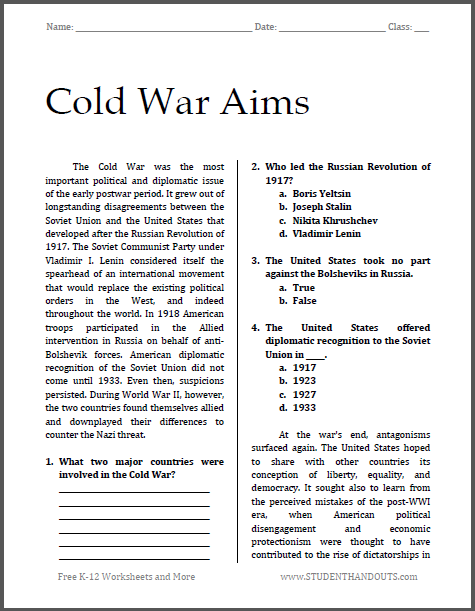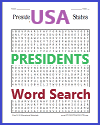Cold War Aims |
|---|
| The Cold War was the most important political and diplomatic issue of the early postwar period. It grew out of longstanding disagreements between the Soviet Union and the United States that developed after the Russian Revolution of 1917. The Soviet communist Party under Vladimir I. Lenin considered itself the spearhead of an international movement that would replace the existing political orders in the West, and indeed throughout the world. In 1918 American troops participated in the Allied intervention in Russia on behalf of antiBolshevik forces. American diplomatic recognition of the Soviet Union did not come until 1933. Even then, suspicions persisted. During World War II, however, the two countries found themselves allied and downplayed their differences to counter the Nazi threat. 1. What two major countries were involved in the Cold War? 2. Who led the Russian Revolution of 1917? a. Boris Yeltsin b. Joseph Stalin c. Nikita Khrushchev d. Vladimir Lenin 3. The United States took no part against the Bolsheviks in Russia. a. True b. False 4. The United States offered diplomatic recognition to the Soviet Union in _____. a. 1917 b. 1923 c. 1927 d. 1933 |
 |
 |
|---|
| This one-sheet (double-sided) worksheet features a reading on the Cold War, interspersed with recall and extension questions. Click here to print (PDF file). |
|---|
| At the war's end, antagonisms surfaced again. The United States hoped to share with other countries its conception of liberty, equality, and democracy. It sought also to learn from the perceived mistakes of the post-WWI era, when American political disengagement and economic protectionism were thought to have contributed to the rise of dictatorships in Europe and elsewhere. Faced again with a postwar world of civil wars and disintegrating empires, the nation hoped to provide the stability to make peaceful reconstruction possible. Recalling the specter of the Great Depression (1929- 1940), America now advocated open trade for two reasons: to create markets for American agricultural and industrial products, and to ensure the ability of Western European nations to export as a means of rebuilding their economies. Reduced trade barriers, American policy makers believed, would promote economic growth at home and abroad, bolstering U.S. friends and allies in the process. 5. Why did the United States advocate open trade following the Great Depression and end of World War II? The Soviet Union had its own agenda. The Russian historical tradition of centralized, autocratic government contrasted with the American emphasis on democracy. Marxist-Leninist ideology had been downplayed during the war but still guided Soviet policy. Devastated by the struggle in which 20 million Soviet citizens had died, the Soviet Union was intent on rebuilding and on protecting itself from another such terrible conflict. The Soviets were particularly concerned about another invasion of their territory from the west. Having repelled Hitler's thrust, they were determined to preclude another such attack. They demanded "defensible" borders and "friendly" regimes in Eastern Europe and seemingly equated both with the spread of communism, regardless of the wishes of native populations. However, the United States had declared that one of its war aims was the restoration of independence and self-government to Poland, Czechoslovakia, and the other countries of Central and Eastern Europe. 6. Approximately how many Soviet citizens died during the years of World War II? 7. Why did the Soviet Union desire "defensible" borders and "friendly" regimes in Eastern Europe? |









